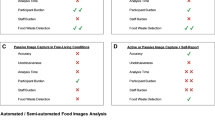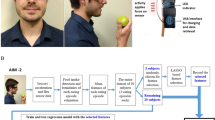Abstract
Background:
Information on dietary intake provides some of the most valuable insights for mounting intervention programmes for the prevention of chronic diseases. With the growing concern about adolescent overweight, the need to accurately measure diet becomes imperative. Assessment among adolescents is problematic as this group has irregular eating patterns and they have less enthusiasm for recording food intake.
Subjects/Methods:
We used qualitative and quantitative techniques among adolescents to assess their preferences for dietary assessment methods.
Results:
Dietary assessment methods using technology, for example, a personal digital assistant (PDA) or a disposable camera, were preferred over the pen and paper food record.
Conclusions:
There was a strong preference for using methods that incorporate technology such as capturing images of food. This suggests that for adolescents, dietary methods that incorporate technology may improve cooperation and accuracy. Current computing technology includes higher resolution images, improved memory capacity and faster processors that allow small mobile devices to process information not previously possible. Our goal is to develop, implement and evaluate a mobile device (for example, PDA, mobile phone) food record that will translate to an accurate account of daily food and nutrient intake among adolescents. This mobile computing device will include digital images, a nutrient database and image analysis for identification and quantification of food consumption. Mobile computing devices provide a unique vehicle for collecting dietary information that reduces the burden on record keepers. Images of food can be marked with a variety of input methods that link the item for image processing and analysis to estimate the amount of food. Images before and after the foods are eaten can estimate the amount of food consumed. The initial stages and potential of this project will be described.
This is a preview of subscription content, access via your institution
Access options
Subscribe to this journal
Receive 12 print issues and online access
$259.00 per year
only $21.58 per issue
Buy this article
- Purchase on Springer Link
- Instant access to full article PDF
Prices may be subject to local taxes which are calculated during checkout





Similar content being viewed by others
References
Bandini LG, Must A, Cyr H, Anderson SE, Spadano JL, Dietz WH (2003). Longitudinal changes in the accuracy of reported energy intake in girls 10–15 y of age. Am J Clin Nutr 78, 480–484.
Black AE, Prentice AM, Goldberg GR, Jebb SA, Bingham SA, Livingstone MB et al. (1993). Measurements of total energy expenditure provide insights into the validity of dietary measurements of energy intake. J Am Diet Assoc 93, 572–579.
Braun M, Martin BR, Kern M, McCabe GP, Peacock M, Jiang Z et al. (2006). Calcium retention in adolescent boys on a range of controlled calcium intakes. Am J Clin Nutr 84, 414–418.
Braun M, Palacios C, Wigertz K, Jackman LA, Bryant RJ, McCabe LD et al. (2007). Racial differences in skeletal calcium retention in adolescent girls with varied controlled calcium intakes. Am J Clin Nutr 85, 1657–1663.
Burke G (2005). The digital classroom: handhelds are dramatically rewriting approaches to 3 R′s. Lafayette Journal and Courier, p B5.
Champagne CM, Baker NB, DeLany JP, Harsha DW, Bray GA (1998). Assessment of energy intake underreporting by doubly labeled water and observations on reported nutrient intakes in children. J Amer Diet Assoc 98, 426–433.
Goodwin RA, Brule D, Junkins EA, Dubois S, Beer-Borst S (2001). Development of a food and activity record and a portion-size model booklet for use by 6- to 17-year olds: a review of focus-group testing. J Amer Diet Assoc 101, 926–928.
Kikunaga S, Tin T, Ishibashi G, Wang DH, Kira S (2007). The application of a handheld personal digital assistant with camera and mobile phone card (Wellnavi) to the general population in a dietary survey. J Nutr Sci Vitaminol 53, 109–116.
Kretsch MJ, Blanton CA, Baer D, Staples R, Horn WF, Keim NL (2004). Measuring energy expenditure with simple, low-cost tools. J Amer Diet Assoc 104 (Suppl 2), A-13.
Larsson CL, Westerterp KR, Johansson GK (2002). Validity of reported energy expenditure and energy and protein intakes in Swedish adolescent vegans and omnivores. Am J Clin Nutr 75, 268–274.
Livingstone MBE, Black AE (2003). Validation of estimates of energy intake by weighed dietary record and diet history in children and adolescents. J Nutr 133, 895S–920S.
Livingstone MBE, Robson PJ, Wallace JMW (2004). Issues in dietary intake assessment of children and adolescents. Br J Nutr 92, S213–S222.
McPherson RS, Hoelscher D, Alexander M, Scanlon KS, Serdula MK (2000). Dietary assessment methods among school-aged children: validity and reliability. Prev Med 31, S11–S33.
Rockett HR, Berkey CS, Colditz GA (2003). Evaluation of dietary assessment instruments in adolescents. Curr Opin Clin Nutr Metab Care 6, 557–562.
Wang DH, Kogashiwa M, Ohta S, Kira S (2002). Validity and reliability of a dietary assessment method: the application of a digital camera with a mobile phone card attachment. J Nutr Sci Vitaminol 48, 498–504.
Yao N, Sclabassi RJ, Liu Q, Yang J, Fernstrom JD, Fernstrom MH et al. (2007). A video processing approach to the study of obesity. Institute of Electrical and Electronics Engineers, International Conference on Manufacturing Engineering [Proceedings of the 2007 International Conference on Multimedia & Expo (ICME); 2–5 July 2007] pp 1727–1730, Beijing, China.
Zhu F, Mariappan A, Boushey CJ, Kerr D, Lutes KD, Ebert DS et al. (2008). Technology-assisted dietary assessment. Proceedings of the IS&T/SPIE Conference on Computational Imaging VI 6814, 1–10.
Acknowledgements
Support for this work comes from the National Cancer Institute (1U01CA130784-01) and the National Institute of Diabetes and Digestive and Kidney Diseases (1R01-DK073711-01A1).
Author information
Authors and Affiliations
Corresponding author
Rights and permissions
About this article
Cite this article
Boushey, C., Kerr, D., Wright, J. et al. Use of technology in children’s dietary assessment. Eur J Clin Nutr 63 (Suppl 1), S50–S57 (2009). https://doi.org/10.1038/ejcn.2008.65
Published:
Issue Date:
DOI: https://doi.org/10.1038/ejcn.2008.65
Keywords
This article is cited by
-
Dietary exposure assessment to food additives: a critical review of food consumption surveys
Nutrire (2024)
-
Emerging trends of technology-based dietary assessment: a perspective study
European Journal of Clinical Nutrition (2021)
-
Nutrition and physical activity intervention for families with familial hypercholesterolaemia: protocol for a pilot randomised controlled feasibility study
Pilot and Feasibility Studies (2020)
-
A systematic review of the validity of dietary assessment methods in children when compared with the method of doubly labelled water
European Journal of Clinical Nutrition (2020)
-
Child diet and health outcomes of the simple suppers program: a 10-week, 2-group quasi-experimental family meals trial
BMC Public Health (2019)



